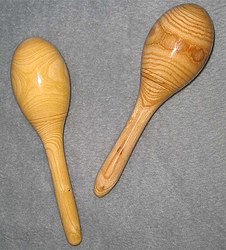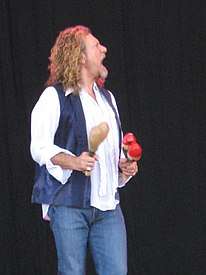Maraca
A maraca (![]()
 | |
| Percussion instrument | |
|---|---|
| Classification | Percussion |
| Hornbostel–Sachs classification | 112.1 (Shaken idiophones or rattles) |
| Related instruments | |
| Shekere | |
| Musicians | |
| Machito, Monguito | |
| Builders | |
| LP Percussion | |
Maracas (Mbaracás),[2] also known as tamaracas, were rattles of divination, an oracle of the Brazilian Tupinamba Indians, found also with other Indian tribes (Garifuna, Guarani) and on the Orinoco and in Florida. Rattles made from gourds (Lagenaria) are being shaken by the natural grip, while the round calabash (Crescentia) fruits are fitted to a handle.[3] Human hair is sometimes fastened on the top, and a slit is cut in it to represent a mouth, through which their shamans (payes) made it utter its responses. A few pebbles are inserted to make it rattle and it is crowned with the red feathers of the Goaraz. Every man had his maraca. It was used at their dances and to heal the sick.[4] Andean curanderos (healers) use maracas in their healing rites.[5]
Modern maraca balls are also made of leather, wood or plastic.[6]
Gallery
 Robert Plant playing two pairs of maracas
Robert Plant playing two pairs of maracas- Guarani shaman holding cross and maraca
- A maraca used by the knights of Toritos de Chichicastenango, danced for the feast of Saint Thomas, around December 21. Each maraca is unique and made specially for each year
References
- Mendes, John (1976). Cote ce Cote la: Trinidad and Tobago Dictionary. Arima, Trinidad: Syncreators. p. 135.
- Antonio Ruiz de Montoya (1876), "Mbaracá", Vocabulario y tesoro de la lengua Guarani (ó mas bien Tupi), 2, Frick, p. 212b
- Julian H. Steward, ed. (1948), Handbook of South American Indians, 3, U.S. Government Printing Office, pp. 43, 129, 238
- Robert Southey (1810), History of Brazil, 1, Longman & Hurst, pp. 187–188, 635
- Federico Kauffmann Doig (2005), "SOUTH AMERICAN INDIANS: INDIANS OF THE ANDES IN THE PRE-INCA PERIOD", in Lindsay Jones (ed.), Encyclopedia of Religion, 13 (2nd ed.), Gale, pp. 8599–8605, ISBN 0-02-865982-1
- Blades, James (1992). Percussion instruments and their history (Rev. ed.). Westport, Conn.: Bold Strummer. ISBN 0-933224-61-3.
External links
